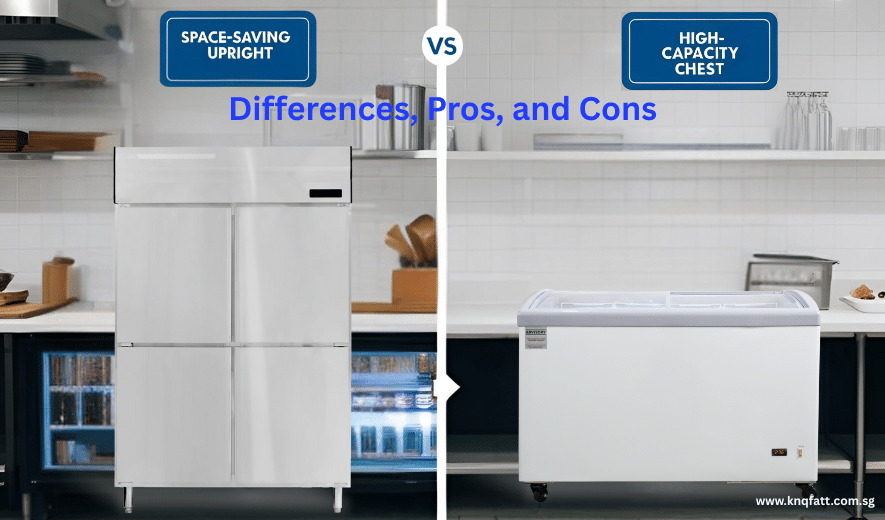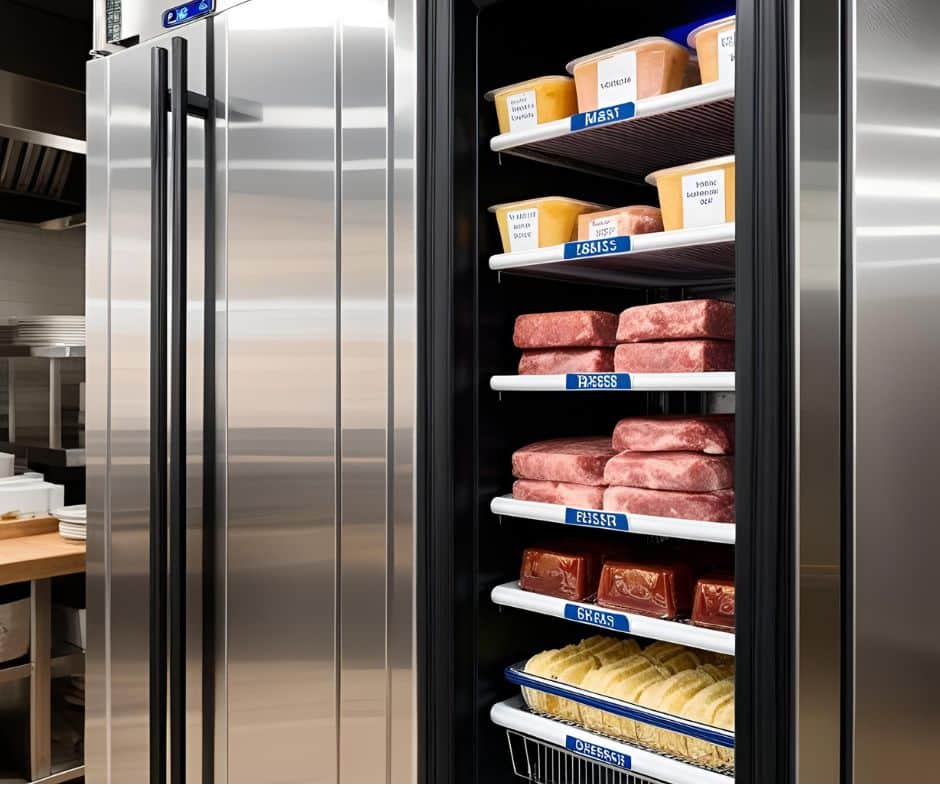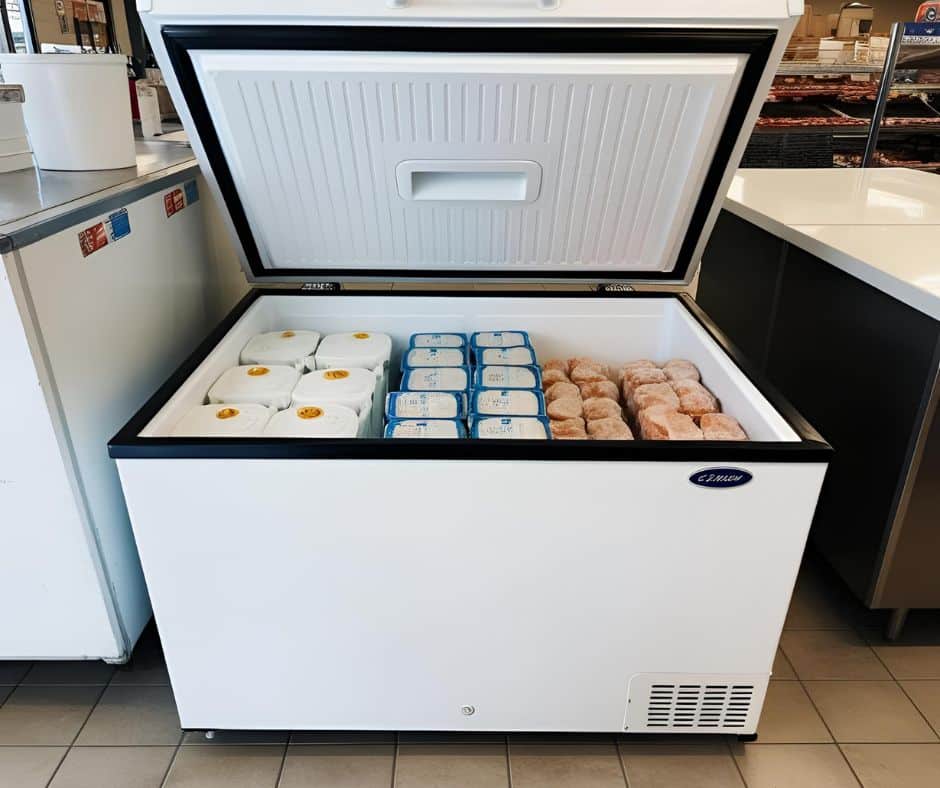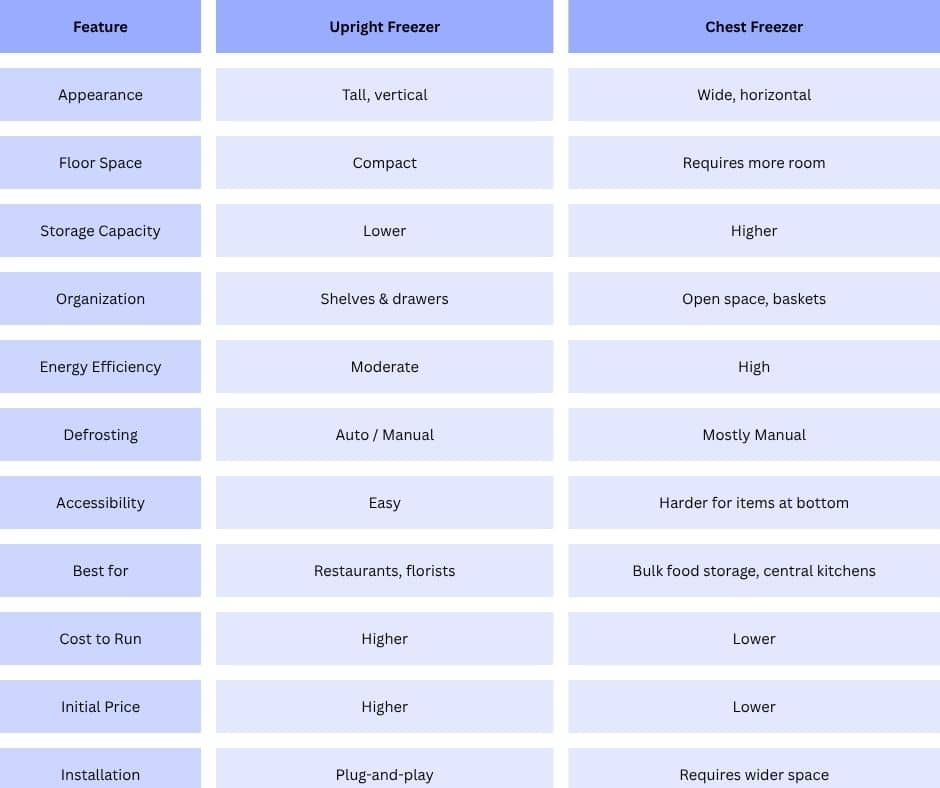Free delivery. Terms and Conditions apply.

Choosing the right commercial freezer can make a significant impact on your business operations—whether you’re running a busy restaurant in Bugis, managing a 24-hour convenience store in Bedok, or stocking up perishables for your catering service in Jurong. In Singapore’s competitive F&B and retail landscape, refrigeration isn’t just about cooling—it’s about consistency, energy efficiency, and long-term investment.
If you’re unsure whether an upright freezer or a chest freezer is best for your needs, this guide is for you.
We’ll help you understand both freezer types, their features, and ultimately how to decide which suits your business operations. This in-depth guide is packed with expert insight and targeted for F&B business owners, florists, restaurant operators, supermarket and minimart owners, and commercial kitchen managers across Singapore.
From cost-efficiency to storage type, maintenance, installation, and noise levels, this article dives deep into each topic with clarity.
An upright freezer is a vertical, front-opening commercial appliance designed for storing frozen goods in an organized, space-efficient manner. Much like a traditional refrigerator, upright freezers come with shelves, drawers, or compartments that make it easy for users to access items without having to bend over or dig through piles of frozen stock.
In the context of commercial use, upright freezers are popular among Singaporean restaurants, flower shops, cloud kitchens, hotels, and convenience stores that have limited floor space but require systematic storage for frozen items. Because of their vertical design, they resemble standard refrigerators and can easily fit into kitchen layouts or back-of-house storage areas without demanding too much space.

Upright freezers are equipped with features tailored to improve storage management and convenience. These include:
Their slim footprint, quick accessibility, and organized design make upright freezers ideal for businesses that require frequent stock rotation or deal with high SKU turnover.
A chest freezer refrigerator, often simply referred to as a chest freezer, is a horizontal, top-opening commercial freezer that offers deep storage space for frozen goods. Unlike upright freezers, chest freezers have a large box-like design that opens from the top, providing businesses with significant storage capacity in a single compartment.
In commercial environments throughout Singapore—especially in wet markets, catering services, hawker stalls, bakeries, and minimarts—chest freezers are preferred for their low energy consumption, durability, and ability to preserve food for longer periods without temperature fluctuations.
Chest freezers are typically used where long-term bulk storage is required. Their ability to maintain low and stable temperatures makes them highly suitable for storing meat, seafood, frozen desserts, and even floral products that require uninterrupted deep freezing.

What are the features of a chest freezer?
Chest freezers offer a different set of features that cater to businesses focused on storage volume and cold retention:
Thanks to their simplicity and efficiency, chest freezers are often seen in back-of-house operations where space allows for wide units, and product visibility is less important than sheer volume and cold-holding power.
The differences between chiller and freezer are already distinct in terms of temperature range and usage, but when it comes to upright freezers vs. chest freezers, the comparison becomes more nuanced—especially for Singaporean businesses making strategic equipment investments.
Whether you’re running a café in Chinatown, a seafood supply store in Toa Payoh, or a central kitchen in Woodlands, understanding how these two types of freezers differ can help you optimize your cold storage system, reduce electricity bills, and improve operational flow.
Below, we’ll dive deep into the critical differences by discussing:
Purpose
Chest freezers are designed primarily for bulk storage and longer freezing durations. Ideal for items that don’t require daily access—like frozen meats, seafood, or pre-prepped ingredients—chest freezers are the go-to for central kitchens and large catering operations.
Upright freezers, on the other hand, serve businesses that require frequent access and organized SKU rotation, such as florists, hotel kitchens, or convenience stores, where time efficiency matters.
Appearance
Upright freezers resemble a standard refrigerator and are vertically built with front-opening doors. They offer a neat, compact look that’s ideal for commercial kitchens with tight vertical spaces.
Chest freezers are boxy, wide, and open from the top. While not always aesthetically pleasing, their appearance reflects practicality and heavy-duty functionality.
Functionality
Build Quality & Size
For businesses with limited width but generous height, upright freezers are a smart fit. For spacious storage rooms or warehouses, chest freezers can maximize floor space efficiently.
Chest freezers require manual defrosting, which involves turning off the freezer, emptying its contents, and allowing the accumulated ice to melt. While labor-intensive, this process extends appliance lifespan and reduces freezer burn.
Upright freezers, however, often come with auto-defrost functions, which save time but may lead to minor temperature fluctuations. These fluctuations can affect temperature-sensitive items like ice cream, certain floral arrangements, or frozen pastries.
In Singapore’s humid climate, where condensation is frequent, upright freezers are more prone to needing frequent gasket replacements and defrost checks.
Chest freezers typically operate at colder and more stable temperatures—ranging between -18°C to -25°C, which is ideal for long-term deep freezing.
Upright freezers usually operate in the range of -15°C to -23°C and may fluctuate slightly more if they feature auto-defrost.
This difference matters greatly for businesses storing high-value proteins or pharmaceutical items, where even a slight increase in temperature can compromise product safety.

Chest freezers offer up to 20% more usable storage space than upright freezers of the same size. The lack of drawers and shelves makes it easier to fit in bulk packaging, cartons, and large meat pieces.
Upright freezers often lose some storage space due to internal shelving systems. However, the trade-off is improved organization and easy access.
This makes chest freezers the better choice for bulk buyers or central cold storage, while upright freezers better serve retailers and outlets with frequent product turnover.
Commercial Upright freezers are best suited for:
Commercial Chest freezers are perfect for:
Chest freezers are generally more affordable to purchase and maintain. Their simple design reduces upfront costs, and they are often cheaper to run due to energy efficiency and fewer mechanical parts.
Upright freezers may cost more, especially if they include digital temperature controls, alarms, or glass doors. However, they offer better inventory management, which might reduce product loss and improve kitchen efficiency.
Upright freezers are easier to fit into tight urban kitchens, as they occupy less floor space and can be aligned with other appliances.
Chest freezers, however, need more horizontal clearance. They’re best installed in storage areas, back rooms, or underutilized hallways in large facilities.
Another consideration: Ventilation space. Upright models often require side and rear clearance, while chest models can often be placed flush against walls (though top clearance is needed).
Chest freezers are typically more energy-efficient, thanks to their deep insulation and top-opening design. Cold air sinks and stays inside even when the door is open, reducing energy waste.
Upright freezers consume more power, especially in frequent-use scenarios. Their vertical design leads to greater cold air escape each time the door opens.
Noise: Upright models with fans and defrost features tend to be louder than chest freezers, which are usually quiet due to their passive cooling design.
Freezer Burn: Because chest freezers maintain more stable temperatures, they’re less likely to cause freezer burn. Upright freezers—especially auto-defrost models—can sometimes dry out exposed food items over time.
Safety: Upright freezers often come with lockable doors, alarms, and digital temperature monitoring, making them a safer choice for regulated storage environments like pharmacies or gourmet shops.
When choosing between an upright freezer and a chest freezer for your business in Singapore, the decision ultimately depends on what your priorities are—storage capacity, convenience, energy efficiency, or space constraints. Here’s a practical look at the pros and cons of both options:
There is no one-size-fits-all answer when it comes to choosing between a freezer chest and an upright freezer. The ideal option depends on your specific business model, the volume and type of items you store, available floor space, and daily operational flow.
Here’s how to make the decision easier based on real-world use cases in Singapore:
Choose an Upright Freezer if your business needs:
Choose a Chest Freezer if your business requires:
Whether you operate a restaurant in Bugis, a florist shop in Chinatown, or a convenience store in Jurong, KnQ Fatt Refrigeration is here to support your commercial refrigeration needs across Singapore. We offer a wide range of commercial refrigerators including upright freezers, chest freezers, and chillers suitable for businesses of all sizes—from small hawker stalls to large hotel kitchens.
Our freezers are:
Not just sellers, we’re also trusted refrigeration repair experts. Our certified technicians handle all types of freezer and chiller repairs—regardless of brand. We serve businesses islandwide, offering fast response, transparent pricing, and genuine parts.
So whether you’re upgrading your equipment or setting up a new outlet, we’ve got your back with reliable freezer units and professional repair support.
A malfunctioning commercial refrigerator can disrupt operations, compromise food safety, and lead to costly inventory losses—especially in Singapore’s heat and humidity. Whether you’re noticing unusual noises, fluctuating temperatures, or excessive frost buildup, knowing the warning signs of refrigerator failure is essential. In this guide, we break down everything you need
Whether you’re running a busy hawker kitchen, managing a cold display in a convenience store, or operating a central kitchen in Changi, your commercial refrigerator is one of your most valuable assets. When maintained properly, it preserves food safety, ensures energy efficiency, and keeps operations running smoothly. But in Singapore’s
Commercial refrigerators are essential for businesses in the food, medical, and retail industries, ensuring that perishable goods remain fresh and safe. However, maintaining the right temperature is crucial for food safety, energy efficiency, and equipment longevity. In this guide, we’ll cover ideal temperature settings, how to maintain them, common temperature
When it comes to running a successful business in Singapore’s food and beverage (F&B) sector, floral supply industry, or restaurant operations, choosing the right refrigeration unit is more than just a matter of storage—it’s a decision that directly affects food quality, customer satisfaction, and energy consumption. Business owners often face

For many businesses in Singapore—whether you’re running a bustling restaurant, a cozy florist shop, or a convenience store—finding the right refrigeration unit is a decision that directly impacts operations. While the options seem endless, two of the most commonly used units in commercial settings are upright refrigerators and undercounter refrigerators.

Commercial refrigeration refers to the specialized cooling systems used to store, preserve, and display perishable goods at controlled temperatures in business environments such as food service, retail, and healthcare. Unlike residential refrigerators, these units are designed for heavy-duty use, ensuring optimal temperature control for large volumes of products, and compliance